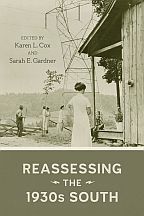
280 pages / 6.00 x 9.00 inches / no illustrations
History / United States - 20th Century | History / United States - Southern History
Much of American popular culture depicts the 1930s South either as home to a population that was intellectually, morally, and physically stunted, or as a romantic, sentimentalized haven untouched by the nation’s financial troubles. Though these images stand as polar opposites, each casts the South as an exceptional region that stood separate from American norms. Reassessing the 1930s South brings together historians, art critics, and literary scholars to provide a new social and cultural history of the Great Depression South that moves beyond common stereotypes of the region.
Essays by Steven Knepper, Anthony J. Stanonis, and Bryan A. Giemza delve into the literary culture of the 1930s South and the multiple ways authors such as Sterling Brown, Tennessee Williams, and E. P. O’Donnell represented the region to outsiders. Lisa Dorrill and Robert W. Haynes explore connections between artists and the South in essays on New Deal murals and southern dramatists on Broadway. Rejecting traditional views of southern resistance to modernization, Douglas E. Thompson and Ted Atkinson survey the cultural impacts of technological advancement and industrialization. Emily Senefeld, Scott L. Matthews, Rebecca Sharpless, and Melissa Walker compare public representations of the South in the 1930s to the circumstances of everyday life. Finally, Ella Howard, Nicholas Roland, and Robert Hunt Ferguson examine the ways southern governments and activists shaped racial perceptions and realities in Georgia, Texas, and Tennessee.
Reassessing the 1930s South provides an interpretation that focuses on the region’s embrace of technological innovation, promotion of government-sponsored programs of modernization, rejection of the plantation legend of the late nineteenth century, and experimentation with unionism and interracialism. Taken collectively, these essays provide a better understanding of the region’s identity, both real and perceived, as well as how southerners grappled with modernity during a decade of uncertainty and economic hardship.
Sarah E. Gardner is professor of history and director of the Center for Southern Studies at Mercer University. She is the author of Reviewing the South: The Literary Marketplace and the Southern Renaissance, 1920-1941.
Karen L. Cox is professor of history at the University of North Carolina at Charlotte. Her most recent book is No Common Ground: Confederate Monuments and the Ongoing Fight for Racial Justice.
Found an Error? Tell us about it.